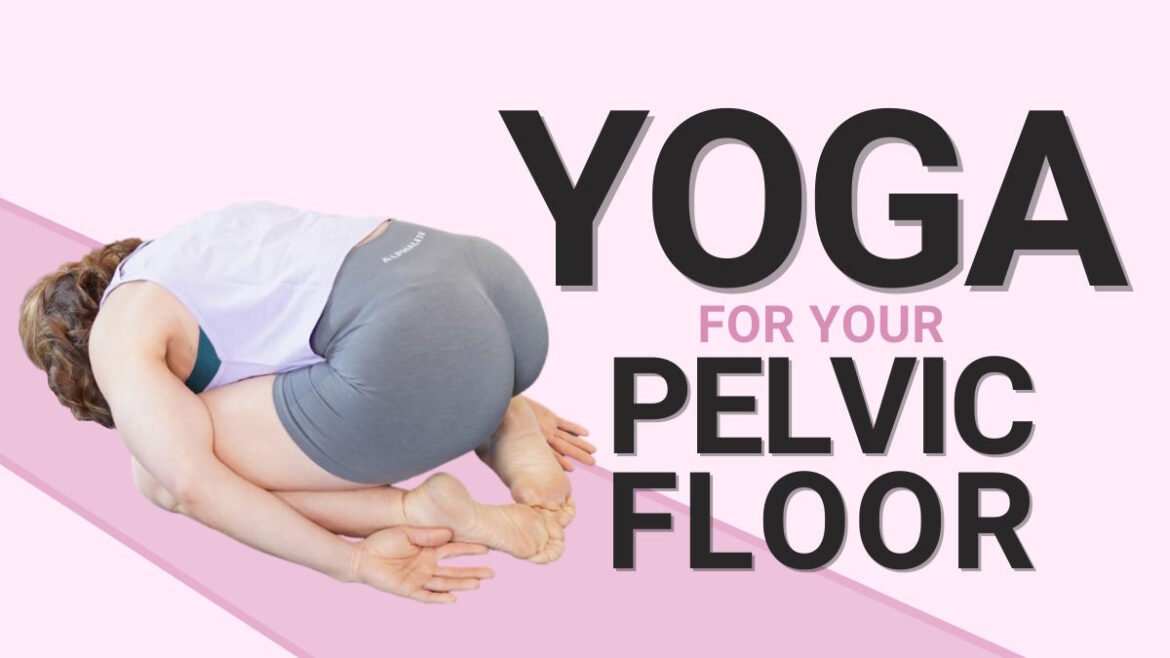Yoga for the pelvic floor is a great tool to help restore optimal pelvic health.
Gentle yoga for the pelvic floor can support the bladder and other pelvic organs, which helps prevent incontinence, build strength and stability, and aid in postpartum healing and recovery.
The good news is that you can practice these yoga exercises in the comfort of your home, with little to no equipment. So, take a deep breath, prioritize your self-care, and let’s explore the benefits of yoga for pelvic floor and how you can get started.
Both Strengthening and Relaxing Your Pelvic Floor Are Important
Approximately one out of every three women experiences pelvic floor dysfunction. This number is likely underreported, as some women may find it embarrassing to report these issues to their primary care physician.
A strong pelvic floor can both lengthen and relax, and contract. The focus is often solely on strengthening of the pelvic floor muscles, but learning to relax these muscles can help with a host of issues including:
- Painful sex
- Stress urinary incontinence
- Back pain
- Hip pain
- Constipation
The Kegel Myth
It is common advice for pregnant and postpartum women to do kegels, but that’s not the whole story. Kegels aren’t the most effective way to improve pelvic floor health. And, if your pelvic floor is already too tight, kegels can actually worsen pelvic floor dysfunction like incontinence and pelvic pain.
A healthy pelvic floor can both strengthen and relax. Yoga can be a great tool for in improving pelvic floor function.
Pelvic Floor Yoga Exercises
Pregnant and postpartum women who practice these yoga poses can often improve their pelvic floor function. These poses both relax and strengthen the pelvic floor muscles when done properly.
Listen to your body, especially if you feel that you’re straining yourself or adding too much tension to your pelvic floor.
Happy Baby (Ananda Balasana)
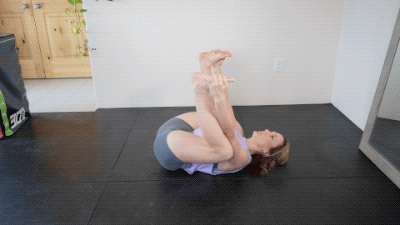
Lay down with your back flat on the floor. Gently bring your knees up to your chest, and grab the out edges of your feet. Feet should be flexed, toes pointed toward face. You can also wrap you fingers around your big toes to further open up your hips.
Inhale down into your rib cage allowing breath to overflow into your tummy.
This pose focuses on relaxation, while also stretching your hips, inner thighs, and groin, and activates the core muscles.
Seated Bound Angle (Butterfly)
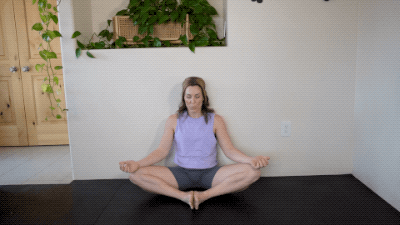
Take a seat on the floor. Bring the soles of your feet together in front of your body while holding your feet with your hands.
This is a great seated-hip opener, allowing the body to relax and be open. The Butterfly pose gently stretches your inner thighs, hips, and groin.
Child’s Pose
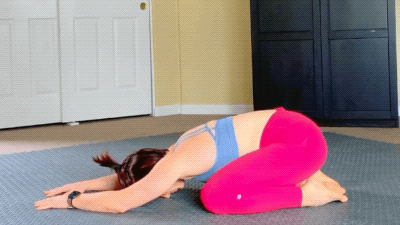
This is a favorite amongst yoga practitioners. First step is to kneel on the floor. Then sink your torso down and towards your thighs. You can place your arms straight out in front of your body or have your hands resting at your sides.
This restorative and calming yoga pose stretches your back and hips.
Cat Cow
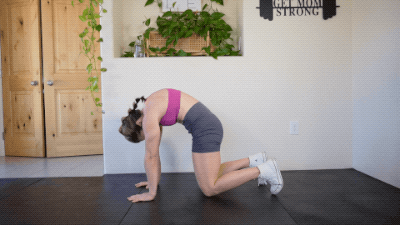
Get down on all fours with your hands directly beneath your shoulders and your knees directly underneath the hips (table top position). Inhale and lift your chest and gently look up. Make sure that your tailbone points towards the ceiling so that your back is arched (Cat Pose).
Next, exhale and press palms into the floor, drawing the belly button towards the spine. Lower your head and tailbone to round your upper back (Cow Pose).
Flowing Cat Cow stretches your spine and engages your core muscles, neck and shoulders.
Reclined Figure 4 (Thread Needle or Reclining Pigeon)
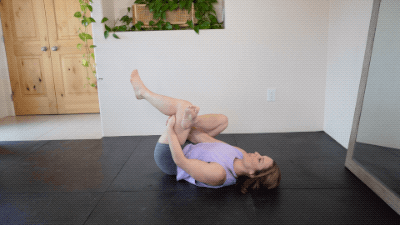
Lie on your back and cross one leg over the other in a figure four position. Reach through the opening you’ve just created with your opposite hand and “thread the needle.” Make sure to inhale deep breaths down into body.
This calming pose focuses on your hips, glutes, and lower back.
Open Book Stretch
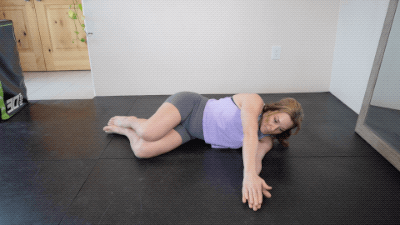
For additional support, grab a yoga block or pillow to use for this exercise and place it on your side. Lie on your back, inhale, and gently twist your spine so that one leg is parallel with the floor and your other knee is resting on the block or pillow. Exhale, and, as if opening a book, stretch your arms out to your sides with palms facing down.
This pose encourages the spine to twist and open.
Bridge Pose With Yoga Block Squeeze

Lie on your back with your feet hip distance apart. With your butt on the ground inhale down into your body.
Exhale and push your hips upwards, and drive your knees into the block. Be careful not to hyperextend your back. Hold and focus on your breath.
This pose strengthens the spine, glutes, and thighs.
Wide-Legged Squat (Malasana)
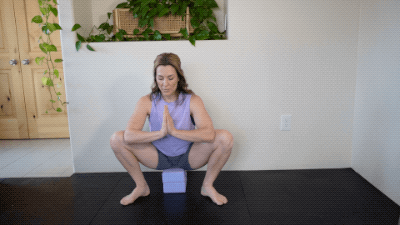
To start, stand with your feet wider than hip distance apart. From here, bend your knees to lower the tailbone towards the ground. Keep your back straight, and press through the feet while engaging your inner thighs and pushing them out to the sides. Make sure to concentrate on your breath.
If you have prolapse, place a block under your butt.
This pose helps to stretch your inner thighs, groin and lower back.
Supported Legs Up The Wall

First, lie on the floor with your hips close to a wall. Then, extend your legs up the wall. Feel a stretch but not so much that you’re uncomfortable. Just breathe here – inhale and exhale.
This pose helps to stretch the hamstrings and calves.
Put a pillow under your butt for gravity assistance if you have prolapse.
Yoga Poses That May Not Be Beneficial for Your Pelvic Floor
Many yoga poses are safe for women with diastasis recti and prolapse. Some yoga poses, however, may cause more strain on the connective tissue of the abdomen.
For example, yoga exercises with twisting and back bends, as well as double leg lifts and flexion core exercises should be avoided if you have diastasis recti.
Take the Time for You
Being a mom is work, and the stresses of mom life can cause you to hold your pelvic floor tight. When you have bladder leaks, your gut reaction is to hold your pelvic floor tighter, but in reality, it wants to be released. Yoga pelvic floor exercises can help you manage issues like this safely. Check out the SLAM Stretch program for a variety of pelvic floor safe yoga flows.
